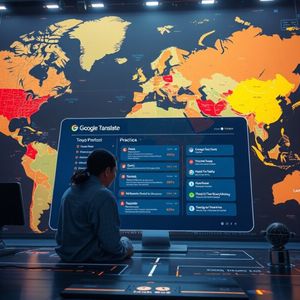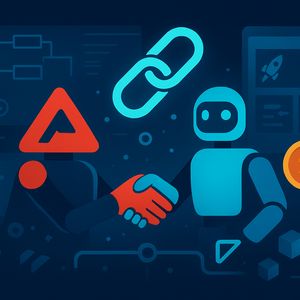BitcoinWorld Google Translate Unleashes Powerful AI Language Learning Tools In the rapidly evolving landscape of artificial intelligence, where innovation drives everything from automated trading algorithms to sophisticated data analysis, the latest advancements from Google Translate are set to revolutionize how we approach Language Learning . For those accustomed to the fast-paced, tech-driven world of cryptocurrencies and digital assets, understanding the power of AI to break down barriers is paramount. Google’s newest AI-powered features for Google Translate are not just incremental updates; they represent a significant leap forward, offering tools that promise to make learning a new language more accessible and efficient than ever before. This development underscores the transformative potential of AI across various sectors, echoing the disruptive spirit seen in the crypto space. The Dawn of AI-Powered Language Learning with Google Translate Google has officially rolled out an experimental, AI-powered feature within Google Translate , specifically designed to help users practice and master new languages. This initiative marks a bold step into the educational technology arena, aiming to provide a comprehensive and adaptive learning experience. The new language practice feature caters to a wide spectrum of learners, from absolute beginners looking to grasp conversational basics to advanced speakers seeking to refine their vocabulary and fluency. It operates by creating tailored listening and speaking practice sessions, which intelligently adapt to a user’s current skill level and individual learning objectives. This personalized approach ensures that each learner receives targeted support, maximizing their progress. The core mechanism involves generative AI, which crafts unique scenarios for users. For instance, learners might engage in simulated conversations, practicing their responses and receiving immediate feedback. This dynamic environment fosters active participation and accelerates the learning curve. By focusing on practical application, Google Translate aims to build not just theoretical knowledge but also genuine communicative competence. Challenging the Status Quo: Google Translate vs. Duolingo With these innovative AI Language Tools , Google is directly entering a competitive space, posing a significant challenge to established platforms like Duolingo. Duolingo has long dominated the language learning market with its gamified approach, making language acquisition fun and accessible for millions. However, Google Translate’s new features offer a different, potentially more immersive and adaptive learning pathway. Personalized Adaptation: Unlike Duolingo’s structured, often linear lessons, Google’s new feature emphasizes adaptive learning. It tailors content based on real-time user performance and stated goals. Real-world Scenarios: The practice sessions are designed to simulate practical conversations, preparing users for actual communication rather than just vocabulary recall or grammar drills. Direct Integration: Being part of Google Translate, users have immediate access to translation capabilities alongside their learning, creating a seamless experience between understanding and practicing. While Duolingo excels in making learning engaging through streaks and leaderboards, Google Translate’s strength lies in its sophisticated AI, offering a more nuanced and responsive learning journey. This competition is ultimately beneficial for users, as it drives further innovation in the language learning sector, offering more diverse and effective tools. How Does the New Language Practice Feature Work? Accessing this groundbreaking feature is straightforward within the Google Translate app. Users will find a dedicated “practice” option, which serves as their gateway to personalized language immersion. Upon selecting this, learners can specify their current skill level – whether they are a complete novice or an advanced speaker – and outline their learning goals. This initial setup is crucial for the AI to calibrate the subsequent practice sessions effectively. Once the parameters are set, Google Translate’s AI generates customized scenarios that allow for two primary modes of practice: Listening Comprehension: Users can listen to simulated conversations, then interact by tapping the words they hear to build comprehension. This mode enhances auditory processing and vocabulary recognition in context. Speaking Practice: Learners can engage in conversational exercises, responding to prompts and scenarios. The AI provides feedback on pronunciation, fluency, and grammatical accuracy, helping users to refine their spoken language skills. The system also meticulously tracks daily progress, providing insights into improvement areas and reinforcing achievements. This data-driven approach allows the AI to continually refine the learning path, ensuring that the content remains challenging yet achievable. The beta experience is currently rolling out for Android and iOS users, initially supporting English speakers practicing Spanish and French, as well as Spanish, French, and Portuguese speakers practicing English. This targeted launch allows Google to fine-tune the AI models and gather crucial user feedback before expanding to a wider array of languages. Breaking Barriers with Real-time Translation Capabilities Beyond the dedicated learning tools, Google Translate is also significantly enhancing its live capabilities, making cross-cultural communication more effortless than ever before. The app now introduces the ability for users to have fluid, back-and-forth conversations with simultaneous audio and on-screen translations. This advancement builds upon existing live conversation experiences, utilizing advanced AI models to facilitate communication in over 70 languages, including Arabic, French, Hindi, Korean, Spanish, and Tamil. Imagine being in a foreign country, needing to ask for directions or negotiate a price, and having Google Translate seamlessly bridge the language gap in real time. To activate this feature, users simply tap the “Live translate” option in the app and speak in their preferred language. The app then instantly translates their speech aloud, simultaneously displaying a transcript of the conversation in both languages. Crucially, the system is intelligent enough to identify pauses, accents, and intonations, allowing for a remarkably natural-sounding dialogue. This level of sophistication ensures that conversations flow smoothly, without the awkward pauses often associated with older translation technologies. Furthermore, Google’s voice and speech recognition models are engineered to isolate sounds effectively, meaning these live capabilities can function remarkably well even in challenging, noisy environments like bustling restaurants or busy airports. This robust performance ensures reliability when it matters most. These live translation capabilities are currently available for users in the U.S., India, and Mexico, with a broader rollout expected to follow. The AI Engine Behind the Magic: Gemini Models and Machine Learning These transformative updates are fundamentally driven by significant advancements in AI and machine learning. Google openly states that its ability to push the boundaries of language processing and understanding stems directly from these technological leaps. The company’s commitment to innovation in this field is evident in the continuous improvement of translation quality, speed, and the expansion to a wider range of languages. A key enabler of these new features is Google’s Gemini models. The integration of Gemini into Google Translate has led to substantial strides in several critical areas: Translation Quality: Gemini models offer more accurate and contextually relevant translations, understanding nuances that previous models might have missed. Multimodal Translation: This refers to the ability to process and translate information across different modalities, such as text, audio, and potentially visual cues, creating a more holistic understanding. Text-to-Speech (TTS) Capabilities: The TTS synthesis is more natural and human-like, enhancing the authenticity of the spoken translations and practice sessions. Google highlights that people collectively translate approximately 1 trillion words across its various platforms annually, including Translate, Search, Lens, and Circle to Search. This immense volume of data fuels the continuous training and improvement of its AI models, creating a powerful feedback loop that enhances the overall user experience. The ultimate goal is clear: to leverage AI to overcome language barriers on a global scale, fostering greater connection and understanding. Why This Matters: Impact on Global Communication and Education The implications of these advanced AI Language Tools extend far beyond individual convenience. On a global scale, they have the potential to democratize access to information and education. For students, these tools can provide an invaluable supplement to traditional language courses, offering personalized practice that adapts to their pace. For travelers, business professionals, and even humanitarian workers, the ability to communicate effectively in real-time, regardless of language, removes significant obstacles. Consider the economic impact: businesses can expand into new markets with greater ease, fostering international trade and collaboration. Cultural exchange can flourish as language is no longer a formidable barrier. While no AI can fully replicate the richness of human-to-human interaction or the depth of cultural immersion, these tools serve as powerful enablers, opening doors that were once closed. The integration of AI into everyday tools like Google Translate also mirrors the broader trend of AI becoming an indispensable part of our digital lives, much like blockchain technology is reshaping financial systems. It’s about making complex tasks simpler and more efficient, ultimately empowering individuals and organizations. Maximizing Your Language Learning Journey with Google Translate To truly leverage the power of these new features, here are some actionable insights for users: Set Clear Goals: When using the practice feature, clearly define what you want to achieve – whether it’s mastering basic greetings, improving business vocabulary, or preparing for a trip. Consistent Practice: Like any skill, language learning benefits from regular, consistent engagement. Utilize the daily progress tracking to stay motivated. Combine with Live Translation: Don’t just practice; use the Real-time Translation feature in real-world scenarios to solidify your learning and gain confidence. Embrace Mistakes: The AI is there to help you learn. Don’t be afraid to make errors; they are part of the learning process, and the system is designed to adapt. Explore Multiple Languages: Once comfortable, consider expanding your linguistic horizons. The more languages you engage with, the more adept you become at language acquisition in general. These tools are not a replacement for dedication, but they are incredibly powerful accelerators, making the journey of language acquisition more engaging and effective. Conclusion: A New Era for Language Learning and Global Communication Google Translate’s latest AI-powered enhancements represent a significant milestone in the quest to break down global communication barriers. By introducing sophisticated Language Learning tools that offer personalized, adaptive practice, and by dramatically improving Real-time Translation capabilities, Google is not just updating an app; it is redefining what’s possible in language acquisition and cross-cultural interaction. The direct challenge to established players like Duolingo signals a new era of innovation, where AI takes center stage in making the world a more connected and understandable place. As AI continues to advance, we can expect even more seamless and intuitive ways to communicate, fostering a truly global community. To learn more about the latest AI market trends, explore our article on key developments shaping AI models and their institutional adoption. This post Google Translate Unleashes Powerful AI Language Learning Tools first appeared on BitcoinWorld and is written by Editorial Team
















